
UVOT Cool Pics
NGC 5204
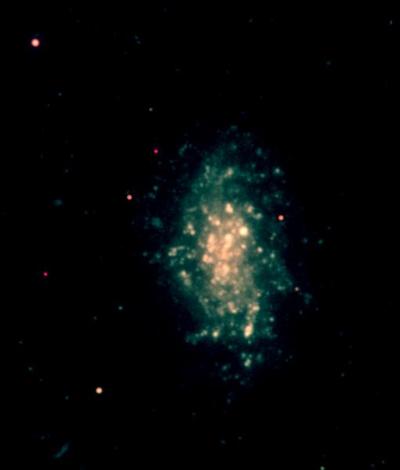
NGC 5204 is a Magellanic Spiral Galaxy located 14.5 million light years away in the constellation Ursa Major and as a part of the M101 Galactic Group. The bright spots, especially the center of the galaxy, indicate areas of active star formation in this false colored UV image (filters: uvw1, uvm2, uvw2). Credit: NASA/Swift/S. Sebzda, PSU
NGC 404
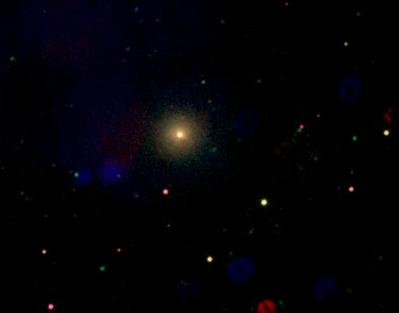
NGC 0404 is a LINER-type (Low Ionization Nuclear Emission-line Region) Active Galaxy Nucleus location 12.5 million light years away. NGC 0404 shines brightly in this false colored UV image (filters: uvw1, uvm2, uvw2). Credit: NASA/Swift/S. Sebzda (PSU)
ESO 0245-G005
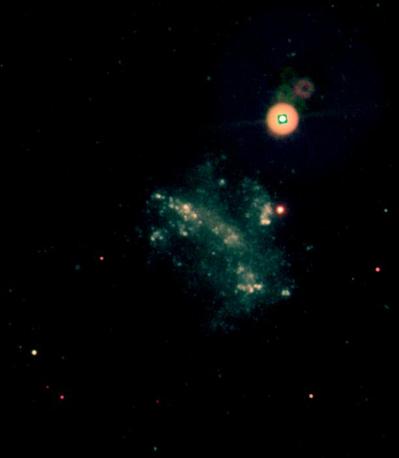
ESO245-G005 is an irregular dwarf galaxy located 14 million light years away. This false color image taken with ultraviolet filters (uvw1, uvm2, uvw2) highlights multiple regions of star formation. Credit: NASA/Swift/S. Sebzda, PSU
UGC 2847
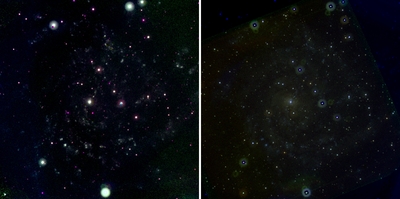
UGC 2847 is an intermediate spiral galaxy located in the constellation Camelopardalis and part of the IC342/Maffei group. UGC 2874 resides near the galactic plane, making observation difficult due to dust. Its distance has been estimated between 7 and 11 million light years away. Active star forming regions can be seen in its arms in the false-color ultraviolet image (left; uvw1, uvm2, uvw2). The extinction due to dust is apparent in the dimness of the optical image (right, u, b, v). Credit: NASA/Swift/S. Sebzda, PSU
UGC 4305
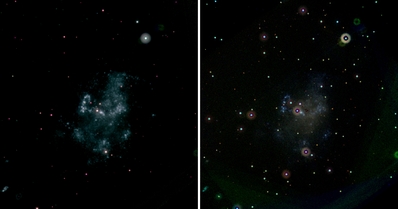
UGC 4305 is an irregular starburst galaxy 11 million light years away in the Ursa Major constellation. The images show false-color ultraviolet (uvw1, uvm2, uvw2) and optical (u, b, v) filters. The UV photo (left) highlights areas of active star formation which are not as noticeable in the optical image (right). Credit: NASA/Swift/S. Sebzda, PSU
NGC 4490
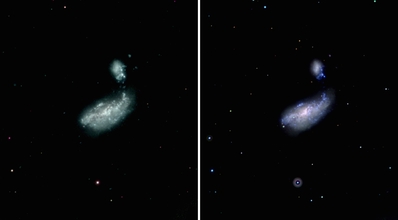
NGC 4490, known as the Cocoon Galaxy, is a starburst galaxy 25 million light years away in the constellation Canes Venatici. The small neighboring galaxy, NGC 4485, orbits NGC 4490, stimulating star formation in both objects, which shows up brightly in this false-color UVOT image (uvw1, uvm2, uvw2). In 2008, Swift observed supernova SN2008ax in this unusual galaxy. Credit: NASA/Swift/S. Sebzda, PSU
NGC 2403 UV/Optical
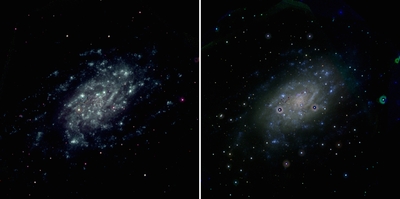
NGC 2403 is a spiral galaxy in the M81 group located 8 million light-years away in the constellation Camelopardalis. At left is a Swift ultraviolet false color image (uvw1, uvm2, uvw2) and at right is the optical image (u, b, v). The ultraviolet highlights ongoing star formation in this nearby galaxy while the optical highlights more of the older stars in the inner regions of the galaxy. Credit: NASA/Swift/S. Sebzda, PSU
NGC 1291
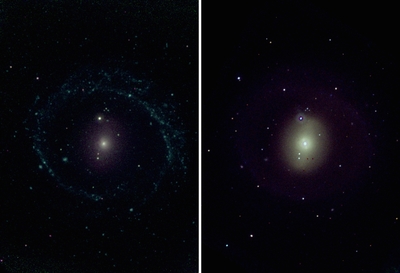
NGC 1291 is a ring galaxy 33 million light years away. The false-color ultraviolet image (uvw1, uvm2, uvw2) on the left can be contrasted against the optical image (u, b, v) on the right. Note how the ring, with its pockets of newly forming stars, stands out in the ultraviolet. Credit: NASA/Swift/S. Sebzda, PSU
NGC 247
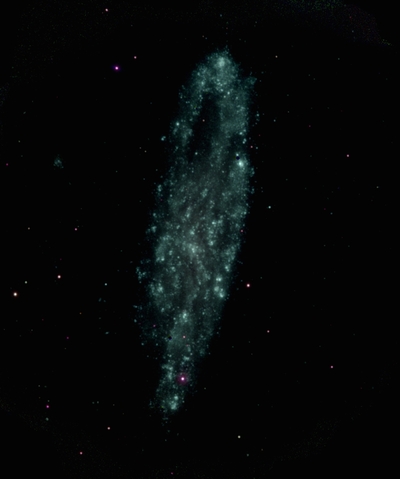
NGC 247 is a spiral galaxy in the Sculptor Group. Eleven million light years away, it shows a remarkable void on one side where there are no young stars. This false-color UVOT image (uvw1, uvm2, uvw2) highlights ongoing active star formation in its long spiral arms. Credit: NASA/Swift/S. Sebzda, PSU
NGC 55
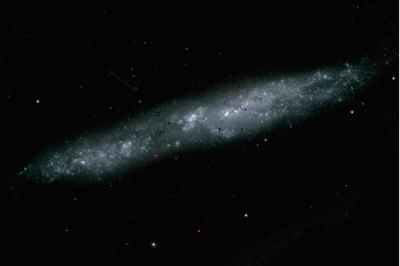
NGC 55 is a barred spiral between the Local Group and Sculptor Group. Seven million light years away, it is seen almost edge on. This false-color UVOT image (uvw1, uvm2, uvw2) highlights ongoing active star formation along its irregular surface. Credit: NASA/Swift/S. Sebzda, PSU
NGC3623
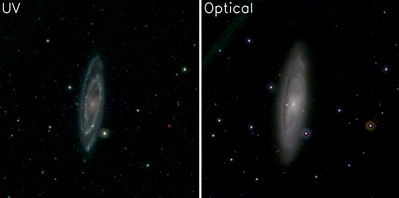
These images are seen in the optical (v, b, and u filters) and ultraviolet (uvw1, uvm2, and uvw2 filters). Credit: NASA/Swift/L.McCauley, PSU.
NGC4395
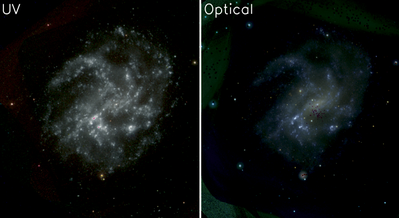
NGC4395 is a small spiral galaxy with no central "bulge" of stars. NGC4395 is ~14 million light-years away, making it a close galactic neighbor. It's central black hole is one of the least massive, and quietest, black holes to be detected in the center of a galaxy. These images are seen in the optical (v, b, and u filters) and ultraviolet (uvw1, uvm2, and uvw2 filters). Credit: NASA/Swift/L.McCauley, PSU.
NGC2903
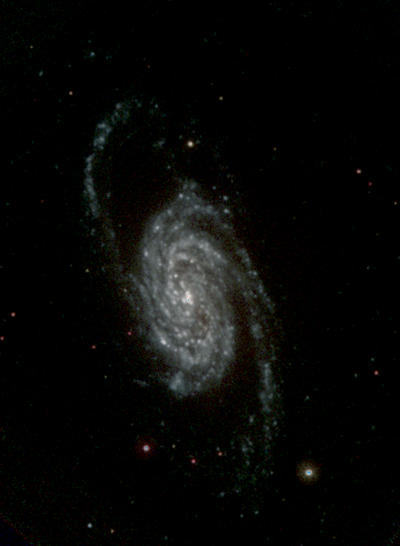
NGC2903 is a barred spiral galaxy ~20 million light-years away located in the spring constellation Leo. NGC2903 exhibits an exceptional rate of star formation activity near its center. Just slightly smaller than the Milky Way, NGC2903 is about 80,000 light-years across. The composite includes ultraviolet exposures through three UVOT filters (uvw1, uvm2, uvw2). NASA/Swift/L.McCauley, PSU.
NGC5474
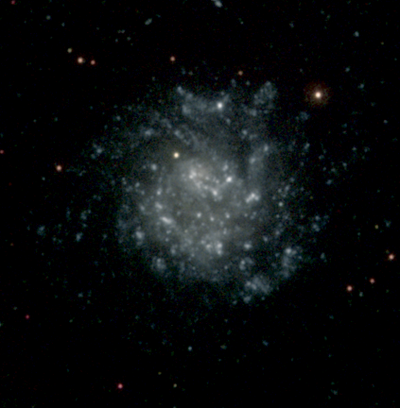
NGC5474 is located in the constellation Ursa Major, and is a dwarf galaxy. Strong gravitational interactions with M101 have distorted the shape of the galaxy therefore offsetting the nucleus of the galaxy from the disk. The composite includes ultraviolet exposures through three UVOT filters (uvw1, uvm2, uvw2). NASA/Swift/L.McCauley, PSU.
NGC6503
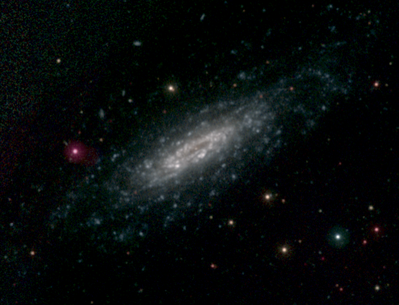
NGC6503 is 18 million light-years away from us in the northern circumpolar constellation Draco. NGC6503 is about 1/3 the size of the Milky Way galaxy. The composite includes ultraviolet exposures through three UVOT filters (uvw1, uvm2, uvw2). NASA/Swift/L.McCauley, PSU.
NGC7090
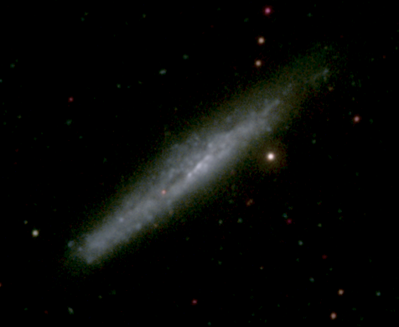
A side on view of NGC7090 shows a disc with a bulging central core. NGC7090 lies in the southern constellation of Indus and is about 30 million light-years away. Astronomer John Herschel first observed this galaxy in 1834. The composite includes ultraviolet exposures through three UVOT filters (uvw1, uvm2, uvw2). NASA/Swift/L.McCauley, PSU.
NGC4214
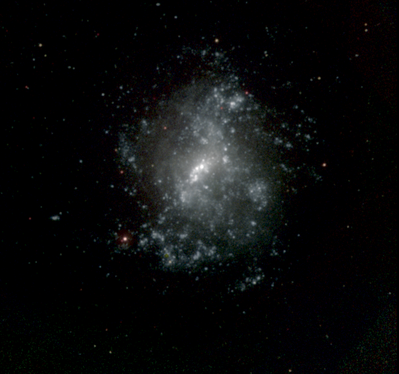
NGC4214 is a dwarf galaxy located ~10 million light-years away in the constellation of Canes Venatici. Although fairly small, it is quite bright with young stars and gas clouds. The composite includes ultraviolet exposures through three UVOT filters (uvw1, uvm2, uvw2). NASA/Swift/L. McCauley, PSU
NGC5236
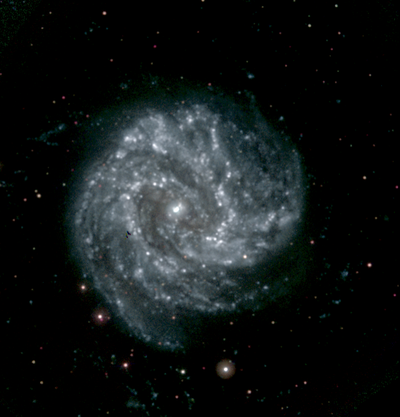
NGC5236 is also known as M83 and is situated in the constellation Hydra. It is the southernmost galaxy in Messier's catalog. M83 is a spiral galaxy about 15 million light years away and is sometimes referred to as the "Southern Pinwheel". The composite includes ultraviolet exposures through three UVOT filters (uvw1, uvm2, uvw2). NASA/Swift/L. McCauley, PSU
NGC3344
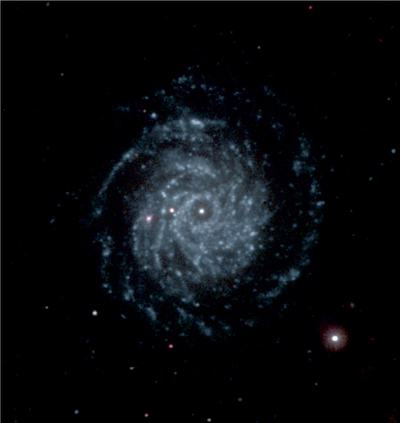
NGC3344 is a spiral galaxy located about 25 million light years away with a subtle bar in the middle. The outer stars of this galaxy move unusually,
leading astronomers to believe that this galaxy passed by another galaxy and acquired some of its stars. The center is predominately made up of
young stars. The composite includes ultraviolet exposures through three UVOT filters (uvw1, uvm2, uvw2). NASA/Swift/L. McCauley, PSU
NGC 7793
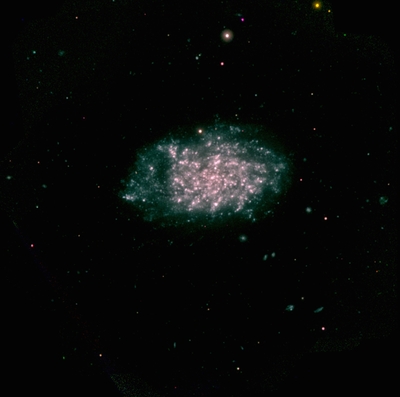
At a distance of 12.7 million light years, NGC 7793 is one of the brightest galaxies in the Sculptor Group. The false-color ultraviolet composite from Swift UVOT's u, uvw1 and uvw2 filters reveals knots of star formation in its tightly-wrapped spiral arms. Credit: NASA/Swift/S. LaPorte, PSU
Supernova in M82
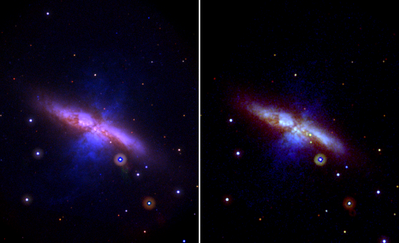
In January of 2014, a supernova exploded in the nearby galaxy M82. At left is a pre-explosion picture composited from uvm2 (blue), u (green) and v (red). At right is the post-explosion picture.
NGC 6624
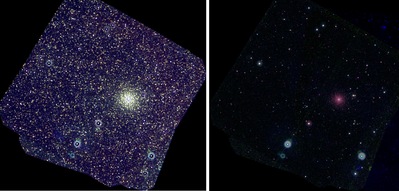
NGC6624 is a metal rich Globular Cluster in the constellation Sagittarius, located 25,700 light years away from the Sun. It hosts six known pulsars and a low-mass X-ray binary. The optical image (left, v, b and u filters) show the cluster amid a rich field of Galactic bulge stars. In the ultraviolet image (right, uvw1, uvm2 and uvw2), most of these stars are too faint to be detected owing to their age, coolness and obscuring foreground dust. Credit: NASA/Swift/J. Linevsky (PSU/CBHS).
M56
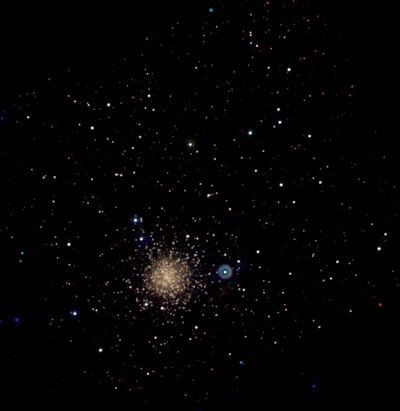
M56 (NGC 6779) is a globular cluster in the constellation Lyra, located 33,000 light years from Earth. It was discovered by Charles Messier in 1779 on the same night he discovered the Comet of 1779. This cluster is one of the many ancient globular clusters in our Galaxy, being approximately 13.7 billion years old. The false-color ultraviolet composite from Swift UVOT's u, uvw1 and uvw2 filters reveals stars that are in various stages of evolution. Credit: NASA/Swift/J. Linevsky, PSU/CBHS
Large Magellanic Cloud
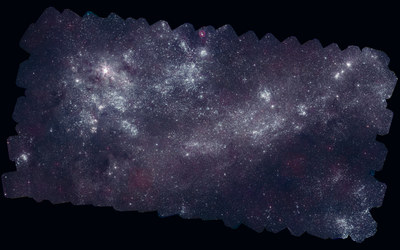
Nearly a million ultraviolet sources appear in this mosaic of the Large Magellanic Cloud, which was assembled from 2,200 images taken by the Ultraviolet/Optical Telescope aboard NASA's Swift satellite. The 160-megapixel image required a cumulative exposure of 5.4 days. The image includes light from 1,600 to 3,300 angstroms -- UV wavelengths largely blocked by Earth's atmosphere -- and has an angular resolution of 2.5 arcseconds. Viewing in the ultraviolet allows astronomers to suppress the light of normal stars like the sun, which are not very bright at these higher energies, and provides a clearer picture of the hottest stars and star-formation regions. The LMC is about 14,000 light-years across. The image is oriented with north at top. Credit: NASA/Swift/S. Immler (Goddard) and M. Siegel (Penn State)
Small Magellanic Cloud
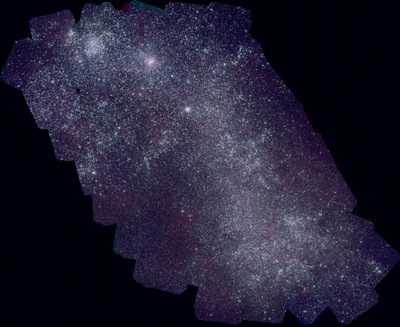
About 250,000 ultraviolet sources appear in this mosaic of the Small Magellanic Cloud, which was assembled from 656 images taken by the Ultraviolet/Optical Telescope aboard NASA's Swift satellite. The 57-megapixel SMC image has a total exposure time of 1.8 days. The image includes light from 1,600 to 3,300 angstroms -- UV wavelengths largely blocked by Earth's atmosphere -- and has an angular resolution of 2.5 arcseconds. Viewing in the ultraviolet allows astronomers to suppress the light of normal stars like the sun, which are not very bright at these higher energies, and provides a clearer picture of the hottest stars and star-formation regions. The SMC is about 7,000 light-years across. The image is oriented with north at top. Credit: NASA/Swift/S. Immler (Goddard) and M. Siegel (Penn State)
UVOT Installation
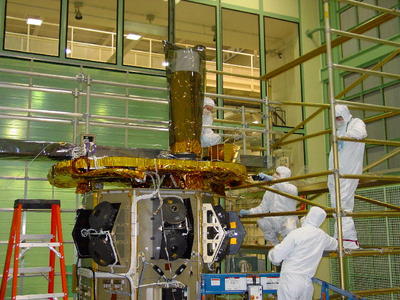
The completed Ultraviolet Optical Telescope was installed on the main body of the Swift spacecraft on December 18, 2002, almost two years before launch at Goddard Space Flight Center.
Supernova 2013ai
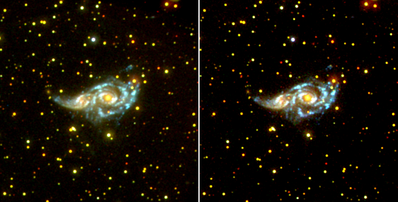
On March 1, 2013, a star in the nearby galaxy NGC 2207 exploded in a rare Type IIP supernova. Swift began observing within 24 hours of the discovery, obtaining the "after" image on the right, which is a composite of the optical and uv images. The before image on the left was obtained during observations of previous supernovae in NGC 2207 in 2010. Credit: NASA/Swift/P. Brown (Texas A&M University).
4C+71.07
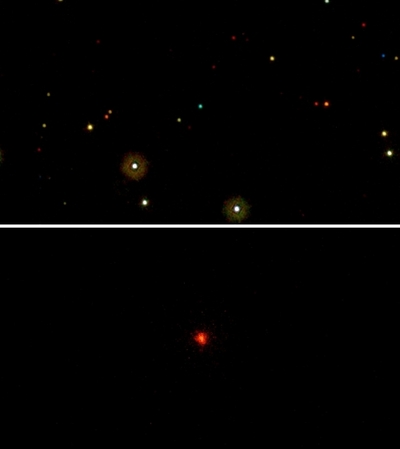
4C +71.07 is an active galaxy 10.6 billion light years away in the constellation of Ursa Major. After being quiet for many years, it went into outburst in late 2011 for several months, pumping out more energy than an entire galaxy of stars as matter fell into its central black hole. The images were taken by Swift's UVOT (top) and XRT (bottom) at the height of the outburst. The UVOT image shows the active galaxy as a blue dot in a composite of optical (v) and ultraviolet (u, uvm2) filters. The X-ray image shows emission in 0.3-1.0 kev range. Credit: NASA/Swift/M. Siegel (PSU)
Omega Centauri
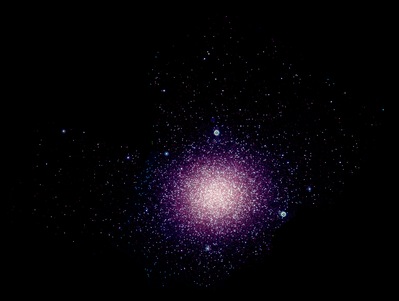
Omega Centauri (also known as NGC 5139) is the largest, brightest and most massive of our galaxy's retinue of 150 or so globular star clusters. Packing some 10 million stars into a region just 150 light-years across, Omega Centauri is easily visible to the unaided eye despite lying nearly 16,000 light-years away. Unlike other star clusters, whose members all have similar age and chemical makeup, those in Omega Centauri display a wide range of age and chemistry, from the ancient (12 billion years) to the relatively recent. The presence of different stellar populations suggests that Omega Centauri is not, in fact, a globular cluster, but the remnant core of a dwarf galaxy torn to shreds by the Milky Way's gravity. The false-color ultraviolet composite from Swift UVOT's uvw1, uvm2 and uvw2 filters reveals a treasure trove of unusual and rare stars that are in various stages of demise. Credit: NASA/Swift/S. Holland (GSFC), M. Siegel and E. Fonseca (PSU)
Westerlund 1
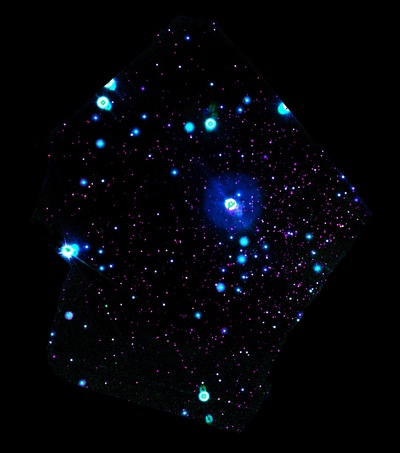
Westerlund 1 is a compact young star cluster in the constellation Ara. With an age no older than 5 million years and a rich population of hot, giant stars, the Westerlund 1 cluster appears to be a nearby example of the "super star clusters" found in galaxies undergoing unusually vigorous star formation (starbursts). This unique stellar menagerie contains at least 200 monster stars with masses upward of 30 times the sun's, from evolved Wolf-Rayet stars and OB supergiants to luminous blue variables and yellow hypergiants. If the solar system were located at the heart of Westerlund 1, the sky would be full of bright stars, many brighter than the full moon. These exotic suns are packed into a region less than six light-years across. Although only 15,000 light-years away, this incredible laboratory for exploring stellar evolution was only recently recognized because it lies hidden behind a good deal of light-absorbing dust, which gives a purplish tinge to this ultraviolet composite from Swift's UVOT (u, uvw1 and uvm2 filters). Credit: NASA/Swift/M. Siegel, PSU
SN 2012aw in M95
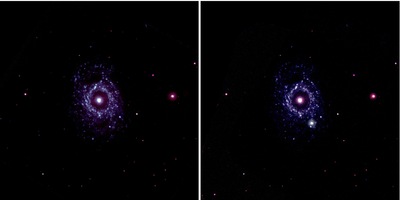
On March 16, 2012, a massive star in the outskirts of the nearby galaxy M95 exploded as a type II supernova. The left image shows the galaxy before the blast, in January 2008. The composite at right includes ultraviolet exposures through three UVOT filters (uvw1, uvm2, uvw2) taken during the week the supernova was discovered, when it outshone its entire parent galaxy. M95 (NGC 3351) lies 33 million light-years away in the constellation Leo. Credit: NASA/Swift/M. Siegel, PSU
SN 2011fe in M101
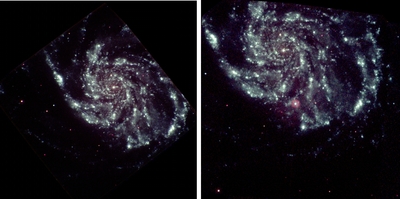
On August 24, 2011, a white dwarf in the spiral arm of the nearby Pinwheel Galaxy (M101) exploded, producing the type I supernova 2011fe. First imaged when it was 1 million times too dim to be seen by the naked eye, SN 2011fe is the earliest detection of a type I supernova to date. The composite ultraviolet image on the left shows the galaxy as it was observed in January 2005 and was the UVOT's "first light" imaging target. The image on the right is centered on the supernova and combines exposures from Sept. 5 and 6, when the eruption was at peak brightness. Credit: NASA/Swift/P. Brown (TAMU) and M. Siegel (PSU)
M105

Messier 105 (also known as NGC 3379) is an elliptical galaxy about 34 million light-years away in the constellation Leo. At left and center, respectively, are Swift UVOT images in the optical (v, b, and u filters) and ultraviolet (uvw1, uvm2, and uvw2 filters). The panel at right shows X-ray observations (0.2-10 keV) from Swift's X-ray Telescope. Credit: NASA/Swift/S. Immler
M102

Messier 102 (also known as NGC 5866) is an edge-on lenticular galaxy in the constellation Draco. Located approximately 48 million light-years away, the galaxy is bisected by a distinct band of dust. At left and center, respectively, are Swift UVOT images in the optical (v, b, and u filters) and ultraviolet (uvw1, uvm2, and uvw2 filters). The panel at right shows X-ray observations (0.2-10 keV) from Swift's X-ray Telescope. Credit: NASA/Swift/S. Immler
M95
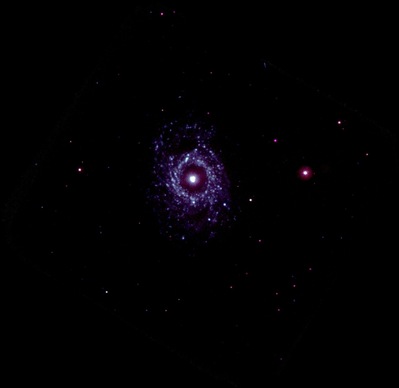
The barred spiral galaxy M95 (NGC 3351) lies 33 million light-years away in the constellation Leo. The barred core appears reddish in this ultraviolet composite due to its old stars, while regions of recent star formation surround the inner galaxy in a blue ring of ultraviolet-bright stellar newborns. This image combines data from the UVOT's uvw1, uvm2 and uvw2 filters. Credit: NASA/Swift/M. Siegel, PSU
M82
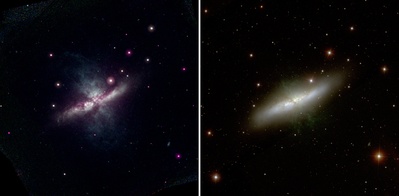
Messier 82, also known as the Cigar Galaxy, is an active starburst galaxy 12 million light-years away in the constellation Ursa Major. The Swift UVOT image (left) highlights the strong dust lanes spanning the middle of the galaxy and streams of gas flowing away from the central region undergoing the starburst. The optical image (right) shows the edge-on spiral disk and only hints at the details seen in the ultraviolet. Credit: NASA/Swift/E. Hoversten, PSU (left) and SDSS (right)
M60

M60 is a giant elliptical galaxy located about 53 million light-years away in the constellation Virgo. The nearby spiral galaxy, NGC 4647, is slightly smaller than our own Milky Way and about 10 million light-years farther off than M60. The two dramatically illustrate the difference between elliptical galaxies - characterized by older stars and little or no dust, gas or recent star formation - and gas-rich spirals like our own Milky Way, which continue to produce large numbers of stars. At left and center, respectively, are Swift UVOT images in the optical (v, b, and u filters) and ultraviolet (uvw1, uvm2, and uvw2 filters). The panel at right shows X-ray observations (0.2-10 keV) from Swift's X-ray Telescope and reveals that the elliptical's core is the dominant source at these energies. Credit: NASA/Swift/S. Immler
Melotte 66
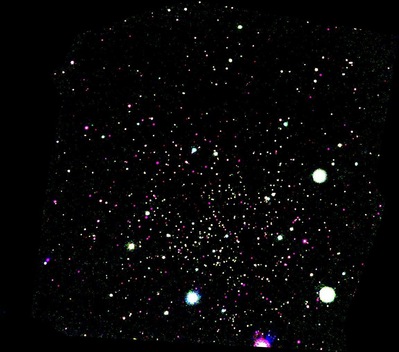
Melotte 66 is an open cluster of ancient stars located 14,000 light-years away in the constellation Puppis. With an age estimated at about four billion years, Melotte 66 ranks among the oldest open clusters in our galaxy. The ultraviolet image reveals some of its youngest and hottest members. The image is a composite of Swift's ultraviolet filters (uvw1, uvm2 and uvw2). Credit: NASA/Swift/B. Porterfield, PSU
NGC 7331 XRT/UVOT

NGC 7331 is a luminous edge-on spiral galaxy about 45 million light-years away in the constellation Pegasus. If we could view it from the outside, our own Milky Way galaxy might look very similar. At left and center, respectively, are Swift UVOT images in the optical (v, b, and u filters) and ultraviolet (uvw1, uvm2, and uvw2 filters). The panel at right shows X-ray observations (0.2-10 keV) from Swift's X-ray Telescope. Credit: NASA/Swift/S. Immler
NGC 7331
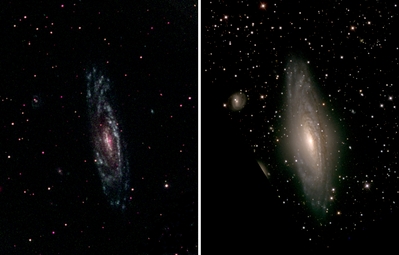
NGC 7331 is a luminous edge-on spiral galaxy about 45 million light-years away in the constellation Pegasus. If we could view it from the outside, our own Milky Way galaxy might look very similar. The image is a composite of Swift's ultraviolet filters (uvw1, uvm2 and uvw2). Credit: NASA/Swift/E. Hoversten, PSU
NGC 7090

NGC 7090 is an edge-on spiral galaxy located 27 million light-years away in the constellation Indus. At left and center, respectively, are Swift UVOT images in the optical (v, b, and u filters) and ultraviolet (uvw1, uvm2, and uvw2 filters). The panel at right shows X-ray observations (0.2-10 keV) from Swift's X-ray Telescope. Credit: NASA/Swift/S. Immler
NGC 6946

NGC 6946, also known as the Fireworks Galaxy thanks to the many supernovae discovered within it, is a face-on spiral located 19 million light-years away in the constellation Cepheus. At left and center, respectively, are Swift UVOT images in the optical (v, b, and u filters) and ultraviolet (uvw1, uvm2, and uvw2 filters). The panel at right shows X-ray observations (0.2-10 keV) from Swift's X-ray Telescope. Credit: NASA/Swift/S. Immler
NGC 6744

NGC 6744, a spiral galaxy 31 million light-years away in the constellation Pavo, might serve as a stand-in for our own Milky Way galaxy. Fluffy spiral arms rich in young star clusters become more distinct in the ultraviolent because the hot young stars emit more high-energy light. At left and center, respectively, are Swift UVOT images in the optical (v, b, and u filters) and ultraviolet (uvw1, uvm2, and uvw2 filters). The panel at right shows X-ray observations (0.2-10 keV) from Swift's X-ray Telescope. Credit: NASA/Swift/S. Immler
NGC 6503
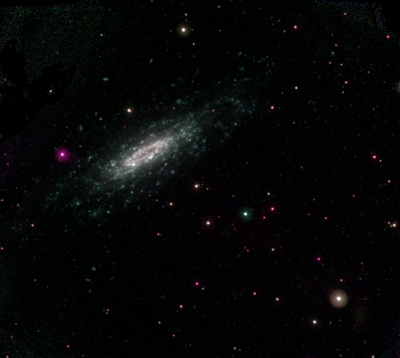
NGC 6503 is an inclined spiral galaxy in the Draco galaxy, 18 million light-years away. It has an active nuclear black hole. The image is a composite of Swift's UV filters (uvw1, uvm2 and uvw2). Credit: NASA/Swift/E. Hoversten, PSU
NGC 6287
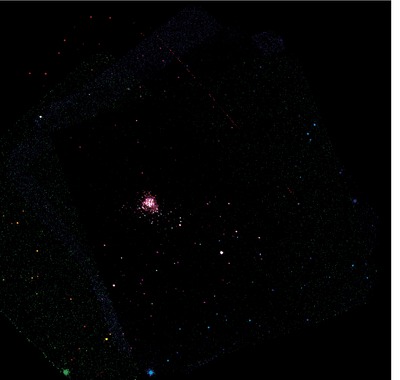
NGC 6287 is a globular cluster, one of about 150 tightly packed balls of ancient stars known to orbit the Milky Way. Located about 31,000 light-years away in the constellation Ophiuchus, NGC 6287 formed more than 10 billion years ago. Its hottest stars shine brightly in this false-color composite of Swift ultraviolet images (uvw1, uvm2 and uvw2). Credit: NASA/Swift/B. Porterfield, PSU
NGC 5584

NGC 5584 is a large spiral galaxy located 78 million light-years away in the constellation Virgo. Graceful bluish spiral arms point to a rich population of star-forming regions and the hot, young blue stars associated with them - an impression confirmed by the ultraviolet view. At left and center, respectively, are Swift UVOT images in the optical (v, b, and u filters) and ultraviolet (uvw1, uvm2, and uvw2 filters). The panel at right shows X-ray observations (0.2-10 keV) from Swift's X-ray Telescope. Credit: NASA/Swift/S. Immler
NGC 5338

NGC 5338 is a galaxy 42 million light-years away in the constellation Virgo. At left and center, respectively, are Swift UVOT images in the optical (v, b, and u filters) and ultraviolet (uvw1, uvm2, and uvw2 filters). The panel at right shows X-ray observations (0.2-10 keV) from Swift's X-ray Telescope. Credit: NASA/Swift/S. Immler
NGC 5253
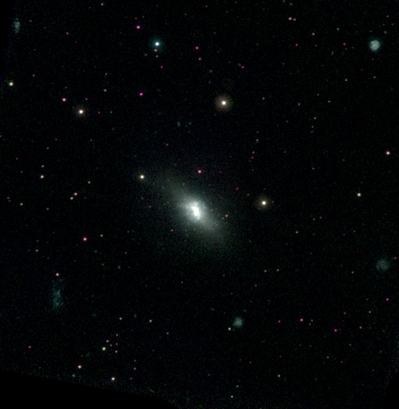
NGC 5253 is a small starburst galaxy located approximately 12 million light-years away in the Centaurus galaxy group. Note the intense ultraviolet light in the galaxy's core from its rapid production of hot, young blue stars. The image is a composite of Swift's UV filters (uvw1, uvm2 and uvw2). Credit: NASA/Swift/E. Hoversten, PSU
NGC 5247

NGC 5247 is a face-on spiral galaxy approximately 72 million light-years away in the constellation Virgo. At left and center, respectively, are Swift UVOT images in the optical (v, b, and u filters) and ultraviolet (uvw1, uvm2, and uvw2 filters). The panel at right shows X-ray observations (0.2-10 keV) from Swift's X-ray Telescope. Credit: NASA/Swift/S. Immler
NGC 4981

NGC4981 is a spiral galaxy located 78 million light-years away in the constellation Virgo. At left and center, respectively, are Swift UVOT images in the optical (v, b, and u filters) and ultraviolet (uvw1, uvm2, and uvw2 filters). The panel at right shows X-ray observations (0.2-10 keV) from Swift's X-ray Telescope. Credit: NASA/Swift/S. Immler
NGC 4654

NGC 4654 is a young gas-rich galaxy located 53 million light-years away in the constellation Coma Berenices. Its distorted shape arises from a combination of its motion through the hot gas distributed throughout the Virgo galaxy cluster and a gravitational encounter with another galaxy perhaps 500 million years ago. Astronomers think encounter fired up a rapid round of star formation called a starburst. At left and center, respectively, are Swift UVOT images in the optical (v, b, and u filters) and ultraviolet (uvw1, uvm2, and uvw2 filters). The panel at right shows X-ray observations (0.2-10 keV) from Swift's X-ray Telescope. Credit: NASA/Swift/S. Immler
NGC 4559

NGC 4559, also known as Caldwell 36, is a spiral galaxy located about 28 million light-years away in the constellation Coma Berenices. A pinwheel of stars gas and dust tipped into our line of sight, the galaxy's spiral structure becomes more prominent in the ultraviolet, where hot, young blue stars produce most of their light. At left and center, respectively, are Swift UVOT composites of images in the optical (v, b, and u filters) and ultraviolet (uvw1, uvm2, and uvw2 filters). The panel at right shows X-ray observations (0.2-10 keV) from Swift's X-ray Telescope. Credit: NASA/Swift/S. Immler
NGC 4449

NGC 4449 is an irregular galaxy located 12 million light-years away in the constellation Canes Venatici. Similar in size and brightness to the Large Magellanic Cloud, a satellite of the Milky Way, NGC 4449 is one of the best-studied and most spectacular examples of a starburst - a galaxy undergoing a powerful episode of star formation - in our galactic neighborhood. At left and center, respectively, are Swift UVOT images in the optical (v, b, and u filters) and ultraviolet (uvw1, uvm2, and uvw2 filters). As the ultraviolet image makes clear, the entire galaxy is rippling with the production of new stars. The panel at right shows X-ray observations (0.2-10 keV) from Swift's X-ray Telescope. Credit: NASA/Swift/S. Immler
NGC 4388

NGC 4388 is a Seyfert 2 active galaxy located 59 million light-years away in the constellation Draco. At left and center, respectively, are Swift UVOT images in the optical (v, b, and u filters) and ultraviolet (uvw1, uvm2, and uvw2 filters). The panel at right shows X-ray observations (0.2-10 keV) from Swift's X-ray Telescope, which better hints at the energies being released in the galaxy's central region. Credit: NASA/Swift/S. Immler
NGC 4236

NGC 4236 is barred spiral galaxy, a member of the M81 group in the constellation Draco and located approximately 14 million light-years away. At left and center, respectively, are Swift UVOT images in the optical (v, b, and u filters) and ultraviolet (uvw1, uvm2, and uvw2 filters). The panel at right shows X-ray observations (0.2-10 keV) from Swift's X-ray Telescope. Credit: NASA/Swift/S. Immler
NGC 4151

NGC 4151, sometimes called the Eye of Sauron, is an active Seyfert 1 galaxy in Canes Venatici and, at 39 million light-years away, is one of the closest galaxies to house a supermassive black hole, which shines brightly in X-rays. At left and center, respectively, are Swift UVOT images in the optical (v, b, and u filters) and ultraviolet (uvw1, uvm2, and uvw2 filters). Note how the outlying spiral arms are more easily visible in the ultraviolet image. The panel at right shows X-ray observations (0.2-10 keV) from Swift's X-ray Telescope. Credit: NASA/Swift/S. Immler
NGC 4030

NGC 4030 is a spiral galaxy in a group located 80 million light-years away in the constellation Virgo. At left and center, respectively, are Swift UVOT images in the optical (v, b, and u filters) and ultraviolet (uvw1, uvm2, and uvw2 filters). The panel at right shows X-ray observations (0.2-10 keV) from Swift's X-ray Telescope. Credit: NASA/Swift/S. Immler
NGC 3953

NGC 3953 is a barred spiral galaxy that lies approximately 60 million light-years away in the constellation Ursa Major and is a member of the Messier 109 galaxy group. At left and center, respectively, are Swift UVOT images in the optical (v, b, and u filters) and ultraviolet (uvw1, uvm2, and uvw2 filters). The latter, which highlights hot, young stars, shows the spiral pattern more clearly. The panel at right shows X-ray observations (0.2-10 keV) from Swift's X-ray Telescope. Credit: NASA/Swift/S. Immler
NGC 3621
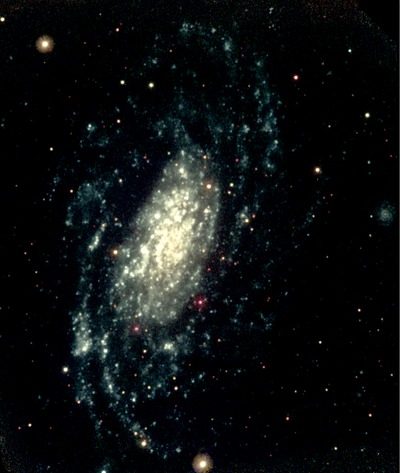
NGC3621 is a spiral galaxy about 22 million light-years away in the constellation Hydra. Chock full of luminous star clusters that show up well in the ultraviolet, the galaxy spans about 100,000 light-years across. This is a composite of images using Swift's UV filters (uvw1, uvm2 and uvw2). Credit: NASA/Swift/E. Hoversten, PSU
NGC 3516

NGC 3516 is an active Seyfert 1 galaxy located 127 million light-years away in the constellation Draco. At left and center, respectively, are Swift UVOT images in the optical (v, b, and u filters) and ultraviolet (uvw1, uvm2, and uvw2 filters). The panel at right shows X-ray observations (0.2-10 keV) from Swift's X-ray Telescope, which highlights high-energy emissions from the galaxy's central black hole. Credit: NASA/Swift/S. Immler
NGC 3184
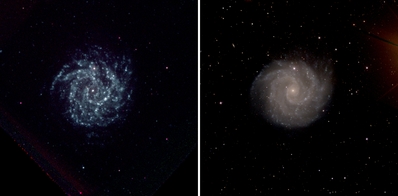
NGC3184 is a face-on spiral galaxy about 39 million light-years away in the constellation Ursa Major. Swift's UVOT highlights the structure in its elaborate spiral arms (left) thanks to clusters of hot, young stars found in regions undergoing star formation. The optical image (right) instead shows all of the stars, partially masking the spiral structure. Credit: NASA/Swift/E. Hoversten, PSU (left) and SDSS (right)
NGC 3054
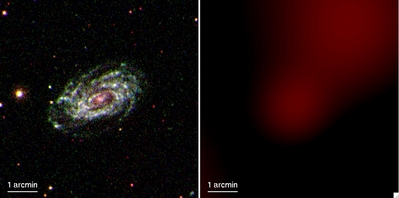
NGC 3054 is a spiral galaxy in the constellation Hydra, 110 million light-years away. At left is the Swift UVOT image in the (uvw1, uvm2, and uvw2 filters). The panel at right shows X-ray observations (0.2-10 keV) from Swift's X-ray Telescope. Credit: NASA/Swift/S. Immler
NGC 2992

NGC 2992 is an active Seyfert-type galaxy in the constellation Hydra that shines brightly in X-rays. At left and center, respectively, are Swift UVOT images in the optical (v, b, and u filters) and ultraviolet (uvw1, uvm2, and uvw2 filters). The panel at right shows X-ray observations (0.2-10 keV) from Swift's X-ray Telescope. Credit: NASA/Swift/S. Immler
NGC 2841
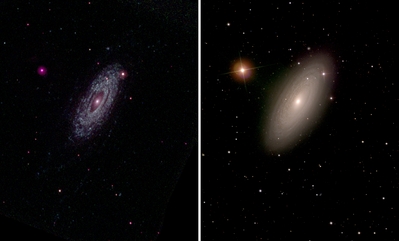
NGC 2841 is a spiral galaxy lying 55 million light-years away in the constellation Ursa Major. The Swift UVOT ultraviolet image (left) shows the young blue stars in symmetrical and tightly wound spiral arms. The optical image (right, SDSS) shows the broad distribution of light from all of the galaxy's stars. Credit: NASA/Swift/E. Hoversten, PSU (left) and SDSS (right)
NGC 2811

NGC 2811 is a spiral galaxy about 49 million light-years away in the constellation Hydra. At left and center, respectively, are Swift UVOT images in the optical (v, b, and u filters) and ultraviolet (uvw1, uvm2, and uvw2 filters). The panel at right shows X-ray observations (0.2-10 keV) from Swift's X-ray Telescope. Credit: NASA/Swift/S. Immler
NGC 2798

NGC 2798 is an interacting galaxy located 88 million light-years away in the constellation Lynx. At left and center, respectively, are Swift UVOT images in the optical (v, b, and u filters) and ultraviolet (uvw1, uvm2, and uvw2 filters). The panel at right shows X-ray observations (0.2-10 keV) from Swift's X-ray Telescope. Credit: NASA/Swift/S. Immler
NGC 2539
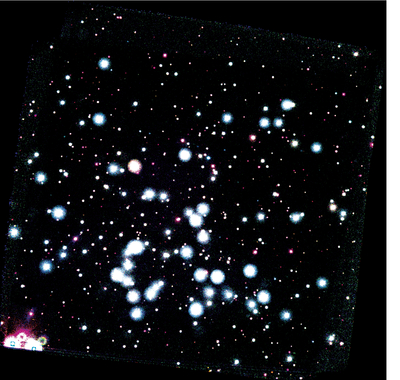
NGC 2539 is an open star cluster located about 4,400 light-years away in the constellation Puppis. At 370 million years old, it is a relative youngster. This false-color ultraviolet image, which reveals some of the youngest and hottest members in the cluster, is a composite from Swift's ultraviolet filters (uvw1, uvm2 and uvw2). Credit: NASA/Swift/B. Porterfield, PSU
NGC 2506
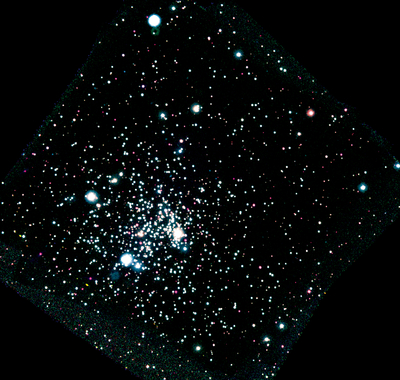
NGC 2506 is an open star cluster lying 11,000 light-years away in the constellation Monoceros. Astronomers estimate that the cluster formed about a billion years ago. This false-color ultraviolet image reveals some of the youngest and hottest stars in the cluster. The image is a composite from Swift's ultraviolet filters (uvw1, uvm2 and uvw2). Credit: NASA/Swift/B. Porterfield, PSU
NGC 2420
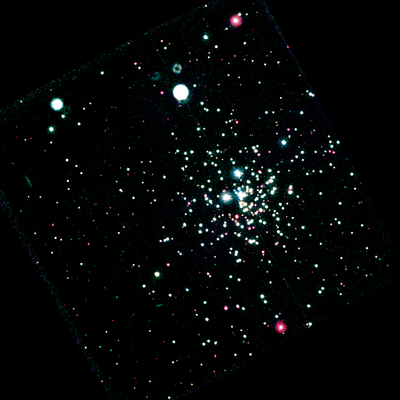
NGC 2420 is an open star cluster 14,000 light-years away in the constellation Gemini estimated to be about a billion years old. This false-color ultraviolet image from Swift's UVOT reveals the youngest and hottest star in this cluster. The image is a composite from Swift's ultraviolet filters (uvw1, uvm2 and uvw2). Credit: NASA/Swift/B. Porterfield, PSU
NGC 2403 XRT/UVOT
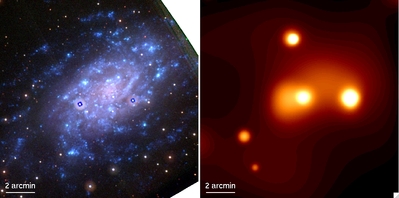
NGC 2403 is a spiral galaxy in the M81 group located 8 million light-years away in the constellation Camelopardalis. At left is a Swift UVOT composite using optical and ultraviolet images (v, u and uvw1 filters), which reveal the galaxy's stellar content. The panel at right shows X-ray observations (0.2-10 keV) from Swift's X-ray Telescope. Credit: NASA/Swift/S. Immler
NGC 2403
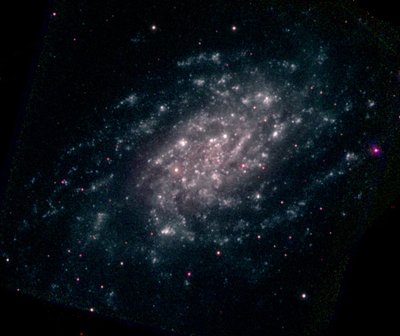
NGC 2403 is a spiral galaxy in the M81 group located 8 million light-years away in the constellation Camelopardalis. Peppered with star-forming regions and the young stars that accompany them, the galaxy is only about 50,000 light-years across. The image is a composite of Swift's UV filters (uvw1, uvm2 and uvw2). Credit: NASA/Swift/E. Hoversten, PSU
NGC 2397

NGC 2397 is a classic spiral galaxy located about 74 million light-years away in the constellation Volans. At left, a Swift UVOT optical image (v, b, and u filters) reveals all of the galaxy's stars, but the ultraviolet view (center; uvw1, uvm2, and uvw2 filters) homes in on the hottest members. The panel at right shows X-ray observations (0.2-10 keV) from Swift's X-ray Telescope, which reveals the galaxy's hottest gas. Credit: NASA/Swift/S. Immler
NGC 2366
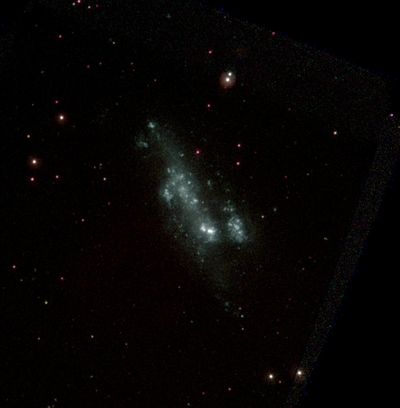
NGC 2366 is an irregular galaxy about 12 million light-years away in the constellation Camelopardalis. Areas rich in hot, young stars and star formation show up well in the ultraviolet, as in this composite taken through Swift's UV filters (uvw1, uvm2 and uvw2). Credit: NASA/Swift/E. Hoversten, PSU
NGC 2304
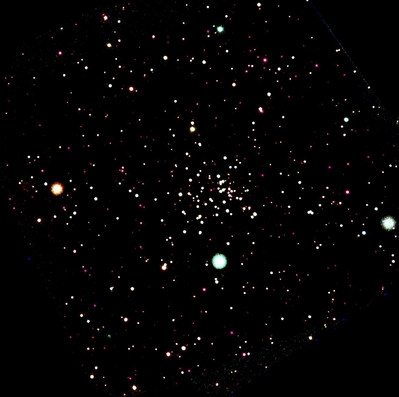
NGC 2304 is an open star cluster in the constellation Gemini. It is located about 13,000 light-years away and has an age estimated at 800 million years. This false-color ultraviolet image from Swift's UVOT reveals the youngest and hottest star in this cluster. The image is a composite from Swift's ultraviolet filters (uvw1, uvm2, and uvw2). Credit: NASA/Swift/M. Siegel, PSU
NGC 2243
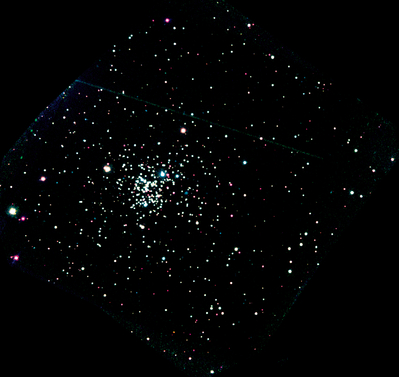
NGC 2243, an open cluster in the constellation Canis Major, appears in this false-color ultraviolet image from Swift's UVOT. Located approximately 15,000 light-years away, NGC 2243 cluster is almost 1.1 billion years old. The ultraviolet image reveals some of the youngest and hottest stars in the cluster. The image is a composite from Swift's ultraviolet filters (uvw1, uvm2 and uvw2). Credit: NASA/Swift/B. Porterfield, PSU
NGC 2204
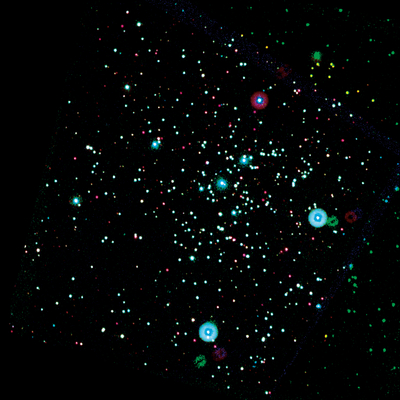
This false-color ultraviolet image shows NGC 2204, an open star cluster located approximately 8500 light-years away in the constellation Canis Major and estimated to be 800 million years old. The ultraviolet image reveals some of the youngest and hottest stars, which produce higher-energy light. The image is a composite from Swift's ultraviolet filters (uvw1, uvm2 and uvw2). Credit: NASA/Swift/B. Porterfield, PSU
NGC 2192
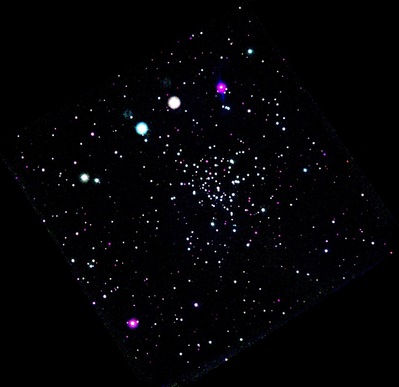
This is a false-color ultraviolet image of NGC 2192, an open cluster located about 12 thousand light-years away in the constellation Auriga. Dated to an age of approximately a billion years, the cluster's youngest and hottest stars pop out when viewed in higher-energy light. The image is a composite from Swift's ultraviolet filters (uvw1, uvm2 and uvw2). Credit: NASA/Swift/B. Porterfield, PSU
NGC 1705
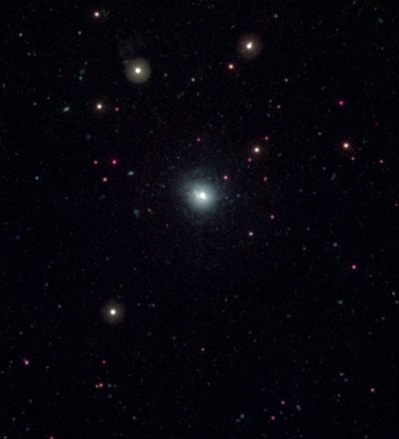
NGC 1705 is a dwarf irregular galaxy located about 17 million light-years away in the Dorado galaxy group. Only about 2,000 light-years across, a size comparable to the satellite galaxies that orbit the Milky Way, most of the light from NGC 1705 comes from young, hot, blue stars in its central cluster. This image is a composite of views through Swift's ultraviolet filters (uvw1, uvm2 and uvw2). Credit: NASA/Swift/E. Hoversten, PSU
NGC 1672

NGC 1672 is a barred spiral galaxy about 47 million light-years away in the constellation Dorado. It possesses a powerful X-ray-bright active nucleus and spiral arms engaged in intense star formation. At left and center, respectively, are Swift UVOT images in the optical (v, b, and u filters) and ultraviolet (uvw1, uvm2, and uvw2 filters). The panel at right shows X-ray observations (0.2-10 keV) from Swift's X-ray Telescope. The galaxy's core shows up brightly at center, and the other two strong sources appear to be starburst regions. Credit: NASA/Swift/S. Immler
NGC 1566
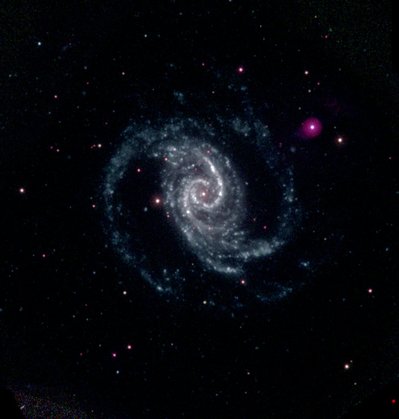
NGC 1566 is a massive complex spiral 39 million light-years distant in the Dorado galaxy group. This composite of Swift's ultraviolet filters (uvw1, uvm2 and uvw2) reveals the galaxy's tightly wrapped inner spiral arms, which shine brightly with rich clusters of hot young stars. Credit: NASA/Swift/E. Hoversten, PSU
NGC 1559

NGC 1559 is a barred spiral galaxy about 51 million light-years away in the constellation Reticulum. Its spiral arms shows up strongly at ultraviolet energies because they are undergoing intense star formation. At left and center, respectively, are Swift UVOT images in the optical (v, b, and u filters) and ultraviolet (uvw1, uvm2, and uvw2 filters). The panel at right shows X-ray observations (0.2-10 keV) from Swift's X-ray Telescope. Credit: NASA/Swift/S. Immler
NGC 1512
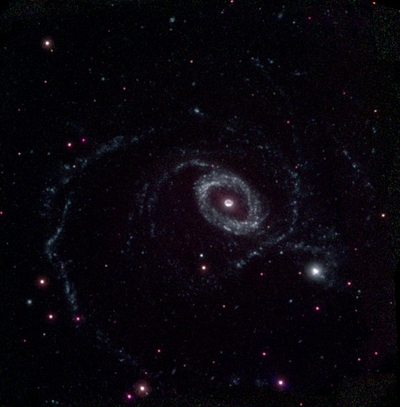
NGC 1512 is a barred spiral galaxy located about 40 million light-years away in the constellation Horologium. The long, delicate spiral arms appear best in ultraviolet light thanks to clusters of hot young stars strung along them. Likewise, a ring of hot stars about 2,400 light-years across surrounds the galaxy's bright core. The image is a composite of Swift's UV filters (uvw1, uvm2 and uvw2). Credit: NASA/Swift/E. Hoversten, PSU
NGC 1482
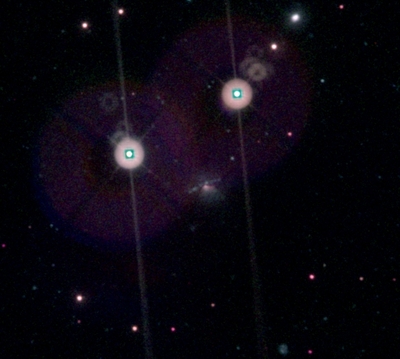
NGC 1482 is a starburst galaxy in the Eridanus cluster, about 64 million light-years away. A starburst galaxy is one undergoing a strong episode of star formation. The image is a composite of Swift's UV filters (uvw1, uvm2 and uvw2). Credit: NASA/Swift/E. Hoversten, PSU
NGC 1404
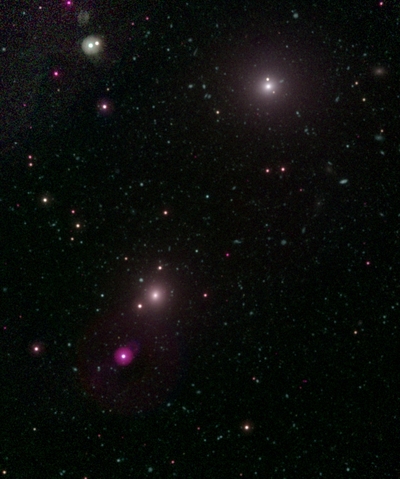
NGC 1404 (left center) and NGC 1399 (top right) are old elliptical galaxies about 63 million light-years away in the constellation Fornax. NGC 1399 lies at the center of the Fornax galaxy cluster, and NGC 1404 is falling toward it. The image is a composite of Swift's UV filters (uvw1, uvm2 and uvw2). Credit: NASA/Swift/E. Hoversten, PSU
NGC 1377
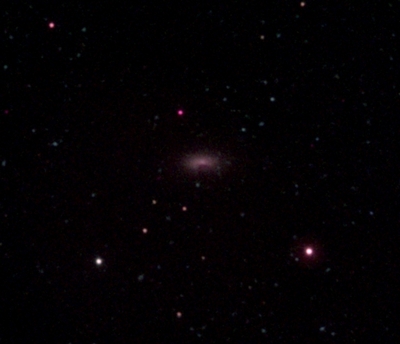
NGC 1377 is an old small faint galaxy is an old faint galaxy 76 million light-years away in the constellation Eridanus. Although it appears unimpressive in this composite of images taken with Swift's UV filters (uvw1, uvm2 and uvw2), infrared observations by NASA's Spitzer Space Telescope indicate that in the last million years it began an episode of explosive star formation. NGC 1377 provides a rare glimpse at the onset of this brief and important phase in a galaxy's life. Credit: NASA/Swift/E. Hoversten, PSU
NGC 1371

NGC 1371 is a spiral galaxy located 76 million light-years away in the constellation Fornax. The galaxy hosts a nuclear bar, which in the visible image (left) clearly marks the origin of two tightly winding spiral arms. At left and center, respectively, are Swift UVOT images in the optical (v, b, and u filters) and ultraviolet (uvw1, uvm2, and uvw2 filters). The panel at right shows X-ray observations (0.2-10 keV) from Swift's X-ray Telescope, showing strong emission from the galaxy's regions that belies its tranquil appearance at lower energies. Credit: NASA/Swift/S. Immler
NGC 1365

The Great Barred Spiral Galaxy, also known as NGC 1365, is 58 million light-years distant in the constellation Fornax. Its long extended spiral arms, spanning some 200,000 light-years, harbor newly born stars that shine brightly in the ultraviolet. At left and center, respectively, are Swift UVOT images in the optical (v, b, and u filters) and ultraviolet (uvw1, uvm2, and uvw2 filters). The panel at right shows X-ray observations (0.2-10 keV) from Swift's X-ray Telescope. Credit: NASA/Swift/S. Immler
NGC 1313

NGC 1313, also known as the Topsy Turvy Galaxy, is a barred spiral located 13 million light-years away in the constellation Reticulum. Its uneven shape and off-center rotation make it unique, and it is currently undergoing a strong episode of star formation, which astronomers call a starburst. At left and center, respectively, are Swift UVOT images in the optical (v, b, and u filters) and ultraviolet (uvw1, uvm2, and uvw2 filters). The panel at right shows X-ray observations (0.2-10 keV) from Swift's X-ray Telescope. It reveals ultraluminous X-ray sources thought to be massive black holes rapidly accreting gas. Credit: NASA/Swift/S. Immler
NGC 1187

NGC 1187 is a spiral galaxy in the constellation Eridanus, 59 million light-years away. At left and right, respectively, are Swift UVOT images in the optical (v, b, and u filters) and ultraviolet (uvw1, uvm2, and uvw2 filters). Credit: NASA/Swift/S. Immler
NGC 1097
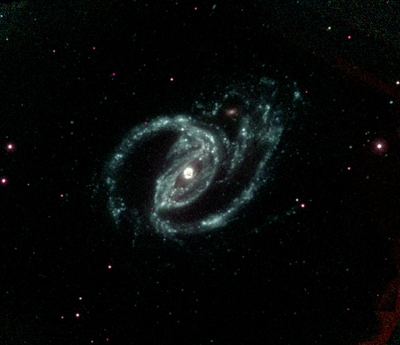
NGC 1097 (also known as Arp 77) is a barred spiral galaxy whose nucleus harbors a massive and active black hole. Situated 61 million light-years away in the constellation Fornax, NGC 1097 has long arcing spiral arms partially affected by the presence of a faint companion at the two o'clock position. The companion is roughly 40,000 light-years from the big galaxy's brilliant eye-like center and is faintly visible in this composite of images from Swift's UV filters (uvw1, uvm2 and uvw2). Credit: NASA/Swift/E. Hoversten, PSU
NGC 1052

NGC 1052 is a Seyfert 2 active galaxy located 64 million light-years away in the constellation Cetus. At left and center, respectively, are Swift UVOT images in the optical (v, b, and u filters) and ultraviolet (uvw1, uvm2, and uvw2 filters). The panel at right shows X-ray observations (0.2-10 keV) from Swift's X-ray Telescope, which highlights emission from the galaxy's central black hole. Credit: NASA/Swift/S. Immler
NGC 925
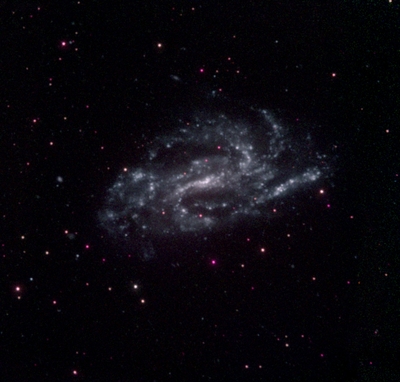
NGC 925 is a barred spiral galaxy located about 28 million light-years away in the constellation Triangulum. This view, a composite of images taken through Swift's UV filters (uvw1, uvm2 and uvw2), highlights hot young stars in the bar and arms. Credit: NASA/Swift/E. Hoversten, PSU
NGC 891

NGC 891 is an edge-on spiral galaxy 33 million light-years away in the constellation Andromeda. Note the dark dust lane that runs across its center, similar to the dust clouds that obscure portions of the central region of our own Milky Way galaxy. At left and center, respectively, are Swift UVOT images in the optical (v, b, and u filters) and ultraviolet (uvw1, uvm2, and uvw2 filters). The panel at right shows X-ray observations (0.2-10 keV) from Swift's X-ray Telescope, which reveals hot gas. Credit: NASA/Swift/S. Immler
NGC 188
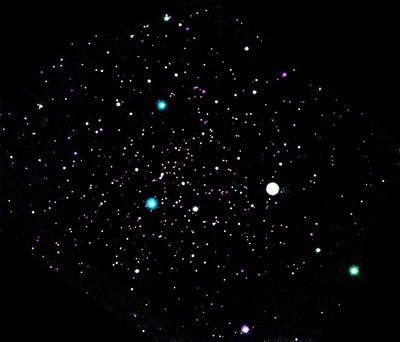
NGC 188 is an ancient open cluster in the constellation Cepheus. This ultraviolet image, a composite of Swift's UV filters (uvw1, uvm2 and uvw2), reveals some of the youngest and hottest stars in the cluster. Credit: NASA/Swift/M. Siegel, PSU
NGC 625
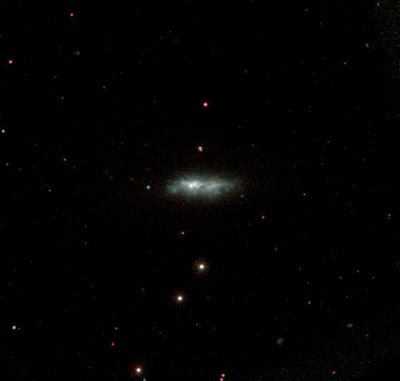
NGC 626 is a barred spiral galaxy in the Sculptor group, 12 million light-years away. The view is a composite of images taken with Swift's UV filters (uvw1, uvm2 and uvw2). Credit: NASA/Swift/E. Hoversten, PSU
NGC 526

NGC 526 is a Seyfert 1 active galaxy in the constellation Ursa Major. Note how luminous it is in the X-ray image, thanks to emissions from the galaxy's central black hole. At left and center, respectively, are Swift UVOT images in the optical (v, b, and u filters) and ultraviolet (uvw1, uvm2, and uvw2 filters). The panel at right shows X-ray observations (0.2-10 keV) from Swift's X-ray Telescope. Credit: NASA/Swift/S. Immler
NGC 300 XRT/UVOT

NGC 300 is a spiral galaxy that lies only 6 million light-years away toward the constellation Sculptor and very close to the Local Group, which includes our own Milky Way galaxy. At left and center, respectively, are Swift UVOT images in the optical (v, b, and u filters) and ultraviolet (uvw1, uvm2, and uvw2 filters). The panel at right shows X-ray observations (0.2-10 keV) from Swift's X-ray Telescope. Credit: NASA/Swift/S. Immler
NGC 300
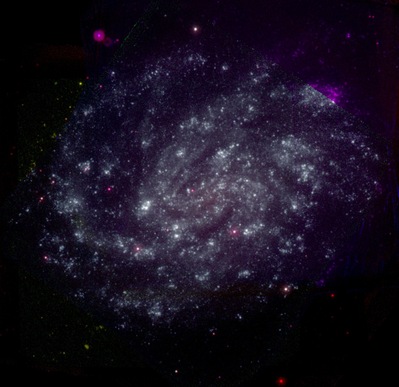
NGC 300 is a spiral galaxy that lies only 6 million light-years away toward the constellation Sculptor and very close to the Local Group, which includes our own Milky Way galaxy. The image is a composite of Swift's UV filters (uvw1, uvm2 and uvw2). Credit: NASA/Swift/E. Hoversten, PSU
NGC 253
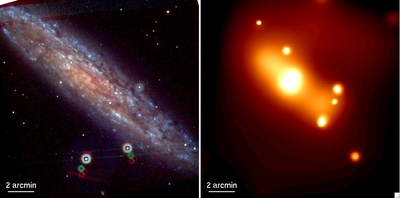
The Sculptor Galaxy is a dazzling spiral galaxy undergoing an intense episode of star formation that classifies it as a starburst galaxy. Only 10 million light-years away, this huge galaxy fills the wide UVOT and XRT fields. At left is a composite Swift UVOT optical-UV image (v, u and uvw1 filters). The panel at right shows X-ray observations (0.2-10 keV) from Swift's X-ray Telescope. Credit: NASA/Swift/S. Immler
NGC 191

NGC 191, 265 million light-years away in the constellation Cetus, consists of two galaxies in the process of merging. The ring of hot ultraviolet-bright stars is probably related to star formation triggered by the passage of the nearby galaxy. At left and center, respectively, are Swift UVOT images in the optical (v, b, and u filters) and ultraviolet (uvw1, uvm2, and uvw2 filters). The panel at right shows X-ray observations (0.2-10 keV) from Swift's X-ray Telescope, which reveals hot gas. Credit: NASA/Swift/S. Immler
NGC 24
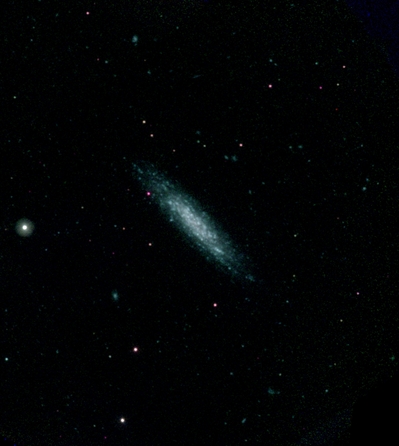
NGC 24 is a small spiral galaxy 22 million light-years away in the constellation Sculptor. This image is a composite of exposures taken through Swift's UV filters (uvw1, uvm2 and uvw2). Credit: NASA/Swift/E. Hoversten, PSU
Maffei 2

Maffei 2 is a spiral galaxy in a large group of galaxies that is one of the closest to the Local Group, which includes our galaxy. Located only 13 million light-years away toward the constellation Cassiopeia, Maffei 2 was not discovered until 1968 because the dust within our own galaxy absorbs most of the light, obscuring all but the most basic features. At left and center, respectively, are Swift UVOT images in the optical (v, b, and u filters) and ultraviolet (uvw1, uvm2, and uvw2 filters). The panel at right shows X-rays (0.2-10 keV) detected by Swift's X-ray Telescope. Credit: NASA/Swift/ S. Immler
M104 XRT/UVOT

The Sombrero Galaxy (Messier 104) is an edge-on spiral galaxy located about 28 million light-years away in the Virgo cluster. A dark dust lane, similar to the dusty regions along the central plane of our own Milky Way galaxy, is prominent in both the Swift optical (left; v, b, and u filters) and ultraviolet (center; uvw1, uvm2, and uvw2 filters). The dust lane is no longer seen in the right image, which shows penetrating X-rays (0.2-10 keV) recorded by Swift's X-ray Telescope. Credit: NASA/Swift/S. Immler
M104
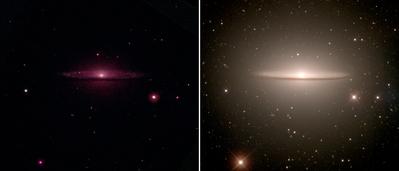
The Sombrero Galaxy (Messier 104) is an edge-on spiral galaxy located about 28 million light-years away in the Virgo cluster. The dark dust lane marks the brim of the "sombrero" that gives this galaxy its name, and is prominent in both the UV (left) and optical (right) images. This lane is formed by dust in the galaxy's central plane, similar to the dusty clouds found along the central plane of our own Milky Way galaxy. Credit: NASA/Swift/E. Hoversten, PSU (left) and SDSS (right).
M101 XRT/UVOT

The Pinwheel Galaxy (Messier 101), a spiral galaxy that lies about 22 million light-years away in the constellation Ursa Major, is so named for its rich, long and well-defined arms. The ultraviolet view (left, uvw1, uvm2, and uvw2 filters) highlights regions of recent star formation, which gives the spiral arms an even more striking and extended appearance than in a comparable view in visible light (right, SDSS). Credit: NASA/Swift/E. Hoversten, PSU (left) and SDSS (right)
M101
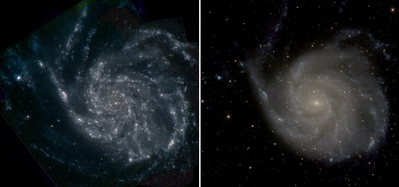
The Pinwheel Galaxy (M101) is a spiral galaxy that lies about 22 million light-years away in the constellation Ursa Major. At left, a Swift UVOT image shows the galaxy at visible wavelengths (v, b, and u filters); at center, the same view in the ultraviolet (uvw1, uvm2, and uvw2 filters). These images show the galaxy's starry content. The view from Swift's X-ray Telescope (right, 0.2-10 keV), however, reveals M101's hot gas and numerous high-energy point sources - typically binary systems containing black holes. Credit: NASA/Swift/S. Immler
M100 XRT/UVOT

M100 (NGC 4321) is a spiral galaxy located about 52 million light-years away in the Virgo cluster. Ultraviolet light traces regions where young hot stars are being formed, while X-rays trace hot gas in the galaxy's nucleus. The left panel shows a Swift UVOT image of M100 in visible light (v, b, and u filters), and the center panel shows the scene in the ultraviolet (uvw1, uvm2, and uvw2 filters). Compare these with the right panel, which shows X-ray observations (0.2-10 keV) from Swift's X-ray Telescope. Credit: NASA/Swift/S. Immler
M100
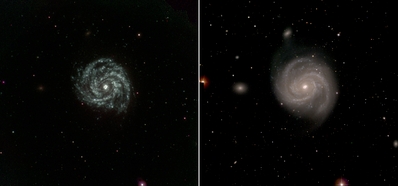
Messier 100 (NGC 4321) is a spiral galaxy located about 52 million light-years away in the Virgo cluster. The optical image (right, Sloan Digital Sky Survey) shows the entire galaxy, while the ultraviolet image (left, Swift) traced the young stars in the spiral arms. Credit: NASA/Swift/E. Hoversten, PSU (left) and SDSS (right).
M83

The Southern Pinwheel, also known as Messier 83, is one of the brightest spiral galaxies in the night sky. It lies 15 million light-years away toward the constellation Hydra. Ultraviolet light traces regions of recent star formation, while hot gas in the nucleus shines in X-rays. Swift UVOT images in visible light (v, b, and u filters) appear at left, and ultraviolet observations (uvw1, uvm2, and uvw2 filters) are shown in the center panel. Compare these with X-ray observations (0.2-10 keV) from Swift's X-ray Telescope at right. Credit: NASA/Swift/S. Immler
M81
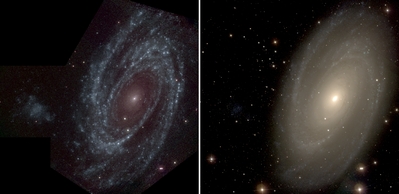
At left is a three-filter (uvw1, uvm2 and uvw2) ultraviolet image of Messier 81, a spiral galaxy 12 million light-years away in the Ursa Major constellation. At right is a visible image from the Sloan Digital Sky Survey. M81's companion galaxy, Holmberg IX, is barely visible in the optical, but its young stars shine brightly in the ultraviolet. Credit: NASA/Swift/E. Hoversten, PSU (left) and SDSS (right).
M74
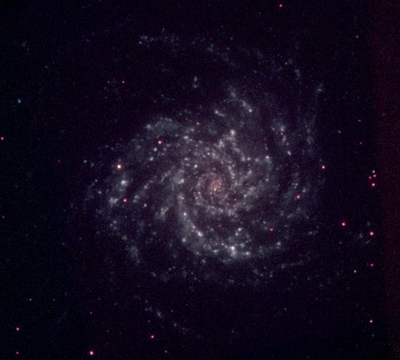
M74 (also known as NGC 628) is a massive grand-design spiral located 30 million light-years away toward the constellation Pisces. The composite of UV light from three filters (uvw1, uvm2 and uvw2) traces the galaxy's long spiral arms all the way to the core of this face-on galaxy. Credit: NASA/Swift/E. Hoversten, PSU
M66
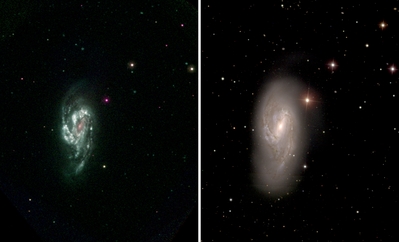
M66 (NGC 3627) is a spiral galaxy about 33 million light-years away and a member the Leo Triplet of galaxies, so named for the constellation in which they appear. The optical image (right, from the Sloan Digital Sky Survey) shows all of the stars, but Swift's UV image (left) highlights the youngest, hottest stars in the spiral arms. Credit: NASA/Swift/E. Hoversten, PSU (left) and SDSS (right).
M63

This is the spiral galaxy M63 (NGC 5055), which lies approximately 27 million light-years away and is a member of the M51 group. The UVOT ultraviolet image on the left shows the view through three filters (uvw1, uvm2 and uvw2) that highlight the young star-forming regions. Compare this to the optical image from Sloan Digital Sky Survey (right). Credit: NASA/Swift/E. Hoversten, PSU (left) and SDSS (right)
M61
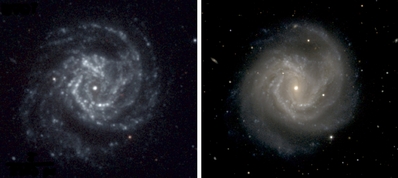
The spiral galaxy M61 (NGC 4303) lies 54 million light-years away in the Virgo galaxy cluster and is one of its largest members. M61 has experienced six supernovae explosions over the past century. Credit: NASA/Swift/E. Hoversten, PSU (left) and SDSS (right)
M51
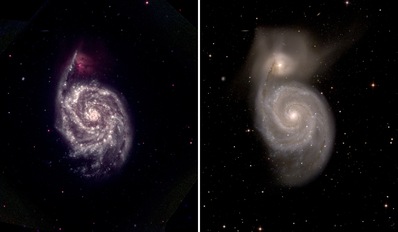
M51, also known as the Whirlpool Galaxy or NGC 5194, is a spectacular face-on grand-design spiral located 23 million light-years away in the constellation Canes Venatici. M51 is interacting with the nearby dwarf galaxy NGC 5195, which seems to be linked to the spiral arm extending toward the top of the image. The dwarf is distinctly redder in the Swift ultraviolet/optical composite (left) than it appears in the visible light image from the Sloan Digital Sky Survey (right). The strong reddening of ultraviolet light indicates the presence of large amounts of dust. Credit: NASA/Swift/E. Hoversten, PSU (left) and SDSS (right)
Holmberg II
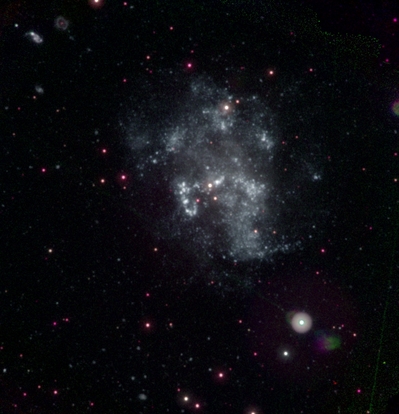
The dwarf galaxy Holmberg II lies 8 million light-years away and is a member of the M81 galaxy group. In this optical and ultraviolet image from Swift's UVOT, the brightest sources are Holmberg II's star-forming regions, where hot young stars emit copious ultraviolet light. Regions filled with cooler, older stars appear as large voids. Credit: NASA/Swift/E. Hoversten, PSU
Holmberg I
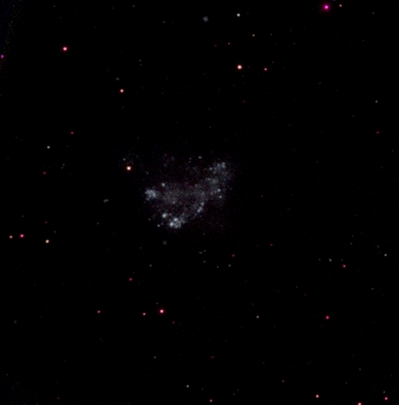
Holmberg I is a dwarf galaxy that lies about 9 million light-years away, and is a member of the M81 galaxy group. Although extremely faint at visible wavelengths, Holmberg I lights up brightly when seen in the ultraviolet due to a population of young stars. This image is an optical/ultraviolet composite made from images taken with Swift's UVOT. Credit: NASA/Swift/E. Hoversten, PSU
Fornax A
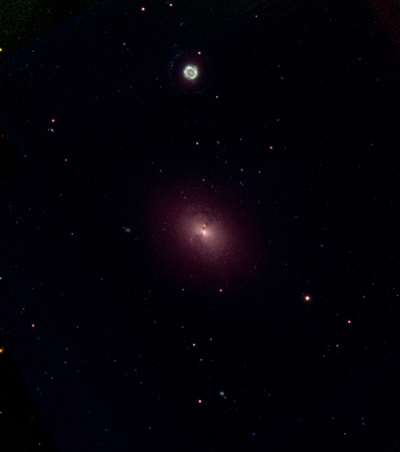
NGC 1316, better known as the strong radio source Fornax A, is an enormous elliptical galaxy located 74 million light-years away in the constellation Fornax. At radio wavelengths, a powerful jet can be detected flowing out of the galaxy's central black hole. This composite of optical and ultraviolet images from Swift's UVOT reveals the galaxy's disk and unusual dust lanes, as well as the nearby spiral galaxy NGC 1317 (top center), with which the larger galaxy appears to be interacting. Credit: NASA/Swift/E. Hoversten, PSU
Fornax A XRT/UVOT

NGC 1316, also known as the strong radio source Fornax A, is an enormous elliptical galaxy located 74 million light-years away in the constellation Fornax. It has unusual dust lanes, an irregular structure. X-ray observations (0.2-10 keV, shown at right) from Swift's XRT reveal a hotspot at the galaxy's center associated with a jet detected in radio data. Optical (v, b, and u filters) and ultraviolet (uvw1, uvm2, and uvw2 filters) data from Swift's UVOT make up the left and center panels, respectively. Credit: NASA/Swift/S. Immler
ESO 506-G027

ESO 506-G027 is Seyfert 2-type active galaxy located about 34 million light-years away in the constellation Hydra. At left and center, respectively, are Swift UVOT images in the optical (v, b, and u filters) and ultraviolet (uvw1, uvm2, and uvw2 filters). The panel at right shows X-ray observations (0.2-10 keV) from Swift's X-ray Telescope. Credit: NASA/Swift/S. Immler
ESO 103-G035

ESO 103-G035 is a Seyfert 2-type active galaxy about 18 million light-years away in the southern constellation Pavo. At left is the galaxy as seen by Swift's Ultraviolet/Optical Telescope in visible light (v, b, and u filters); in the center is the ultraviolet view (uvw1, uvm2, and uvw2 filters). X-ray band data (0.2-10 keV) from Swift's X-Ray Telescope make up the right panel. Credit: NASA/Swift/S. Immler
ESO 245-G005
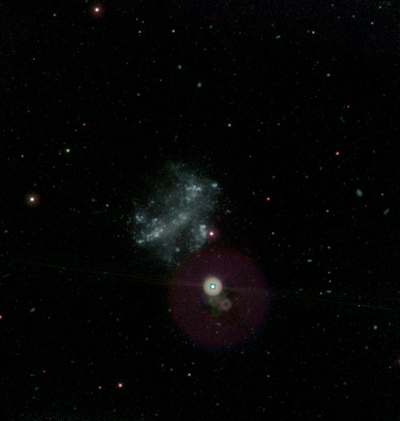
ESO 245-G005 is a small irregular galaxy about 18 million light-years away, a member of the M81 group. The galaxy's bright young stars stand out in Swift UVOT's ultraviolet image (uvw1, uvm2 and uvw2). Credit: NASA/Swift/E. Hoversten, PSU
DDO 53
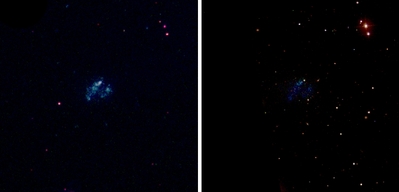
DDO 53 is a dwarf irregular galaxy about 12 million light-years away, a member of the M81 group. Although the galaxy is faint in visible light (right, SDSS), its young stars shine in the composite ultraviolet image (uvw1, uvm2 and uvw2) from Swift's UVOT (left). Credit: NASA/Swift/E. Hoversten, PSU
Circinus

The Circinus Galaxy is a Seyfert-type active galaxy that is ejecting rings of gas. It is one of the closest active galaxies to the Milky Way, lying only 13 million light-years away in the constellation Circinus. At left is the optical view (v, b, and u filters) and at center is the ultraviolet (uvw1, uvm2, and uvw2 filters) view from Swift's Ultraviolet/Optical Telescope (UVOT). The panel at right shows X-ray (0.2-10 keV) observations from Swift's X-Ray Telescope. Credit: NASA/Swift/S. Immler
Stephan's Quintet

Stephan's Quintet is a compact group of interacting galaxies located about 270 million light-years away in the constellation Pegasus. (NGC 7320, at lower left, is actually an unrelated galaxy in foreground, some 40 million light-years closer to us.) A shock wave from colliding gas is very bright at X-ray energies, while newborn stars shine brightly in the ultraviolet. This compact galaxy group was featured in the movie classic "It's a Wonderful Life." The left image shows the optical field (v, b, and u filters) and the center shows the ultraviolet view (uvw1, uvm2, and uvw2 filters) from Swift's Ultraviolet/Optical Telescope (UVOT). At right is an X-ray band image (0.2-10 keV) from the satellite's X-Ray Telescope (XRT). Credit: NASA/Swift/S. Immler
Arp 224

Arp 224 (also known as NGC 3921) is located 267 million light-years away in the constellation Ursa Major. It consists of two galaxies in the process of merging into a single object. This interaction creates new stars, which are highlighted in the ultraviolet image. This panel shows the galaxy in the optical (left, in v, b, and u filters) and ultraviolet (center, in uvw1, uvm2, and uvw2 filters) as seen by Swift's Ultraviolet/Optical Telescope (UVOT), and in X-ray observations (right, 0.2-10 keV) from the satellite's X-Ray Telescope (XRT). Credit: NASA/Swift/S. Immler
Supernova in NGC1365
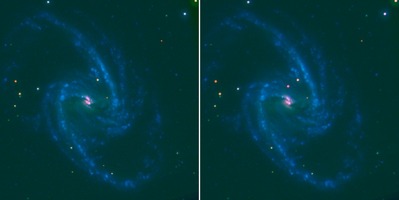
On October 27, 2012, a star exploded in a Type Ia supernova in the nearby barred spiral NGC 1365. This remarkably bright supernova has been followed by Swift ever since. The composite image of uvw1, uvw2 and uvm2 show the galaxy before (left) and after (right) the supernova. Credit: NASA/Swift/P. Brown (Texas A&M)
SN 2011dh in M51
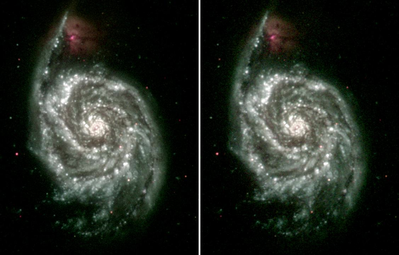
At left is an ultraviolet composite (uvw1, uvm2, uvw2 filters) from images of the Whirpool Galaxy (M51) taken from between 2005 and 2007. The composite at right uses the same filters and was made from observations taken in June 2011, shortly after astronomers detected the explosion of a massive star - a type II supernova - in one of the galaxy's outer spiral arms. The object, dubbed SN 2011dh, is visible at about the 8 o'clock position at the galaxy's edge. Compare the two images to find the "new star." Credit: NASA/Swift/E. Hoversten, PSU
M81
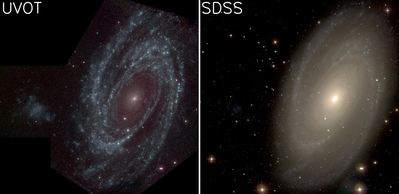
Messier 81 and Holmberg IX (Swift/Penn State/E. Hoversten) - At left is an ultraviolet image of Messier 81 (M81) from Swift UVOT, and at right is a visible light image from the Sloan Digital Sky Survey telescope. To the left of M81 you can also see the dwarf galaxy Holmberg IX.
Chandra Deep Field South
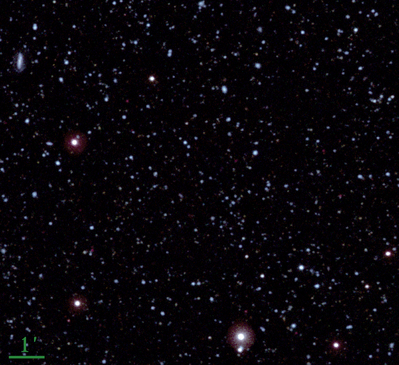
The Chandra Deep Field South is a small spot on the sky that has been studied extensively by a wide variety of observatories. Swift observed this field for more 523,000 seconds - 136,000 in w2 filter (blue); 131,000 in m2 (green); 154,000 in w1 (red); and 102,000 in u (not pictured). That's a total exposure of just over six days stretched over several months. The 1,200 blue smudges peppering this image are all distant galaxies. For reference, the green line at the bottom is one arcminute, or about 30 times smaller than the diameter of a full moon. Credit: NASA/Swift/E. Hoversten, PSU
Crab Nebula

The Crab Nebula is the wreckage of an exploded star, or supernova, seen in the year 1054. The expanding cloud of gas is located 6,500 light-years away in the constellation Taurus. This composite of three Swift UVOT ultraviolet images (uvw1, uvm2 and uvw2) highlights the luminous hot gas in the supernova remnant. Credit: NASA/Swift/E. Hoversten, PSU
Centaurus A
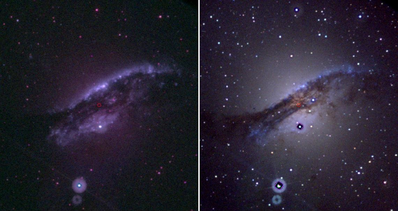
Centaurus A, also known as NGC 5128, is the nearest "active" galaxy, a powerful emitter of X-rays and radio waves. Located 12 million light-years away, the galaxy's rugged dust lane and ultraviolet-bright star clusters are thought to have been forged by the mergers of two smaller galaxies. Deep in Centaurus A's heart, a location marked by a circle in both images, lurks a supermassive black hole containing about 1 billion times the sun's mass. Matter falling toward the black hole fuels Centaurus A's extraordinary radio and X-ray activity. At left is the ultraviolet view from Swift's UVOT; the view in visible light is at right. Credit: NASA/Swift/E. Hoversten, PSU
GRB 080310
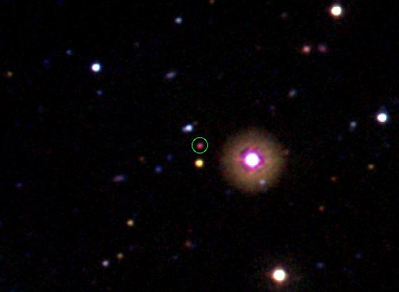
GRB 080310 (Swift/Penn State/E. Hoversten) - At 08:37 GMT on March 10, 2008, Swift detected a gamma ray burst now known as GRB 080310. Here is an color visible light picture of the burst (inside the green circle) from UVOT. Ground based spectroscopic observations from Lick Observatory in the mountains east of San Jose, California determined a distance of 10.9 billion light years to the GRB.
UVOT Vibration Testing
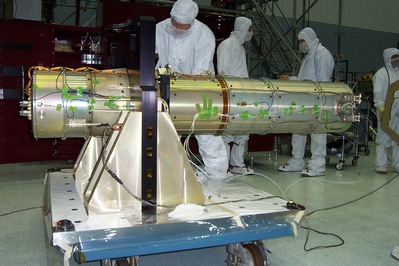
Technicians prepare Swift's UVOT for vibration testing on Aug. 1, 2002, more than two years before launch, in the High Bay Clean Room at NASA's Goddard Space Flight Center. Credit: NASA's Goddard Space Flight Center
Galaxy M33
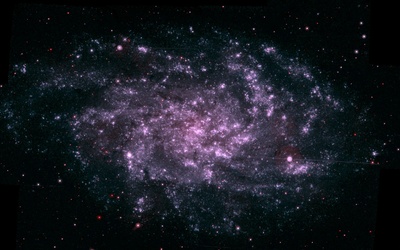
A Swift UVOT UV mosaic of 13 observations (red: uvw1, green: uvm2, blue: uvw2) of M33. The 13 individual pointings (with 1 ks exposure time per UVOT UV filter) cover the entire disk of the galaxy.
Galaxy M31
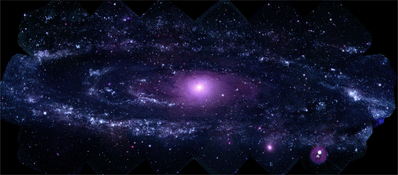
This mosaic of M31 merges 330 individual images taken by the Ultraviolet/Optical Telescope aboard NASA's Swift spacecraft. It is the highest-resolution image of the galaxy ever recorded in the ultraviolet. The image shows a region 200,000 light-years wide and 100,000 light-years high (100 arcminutes by 50 arcminutes).
Comet Lulin
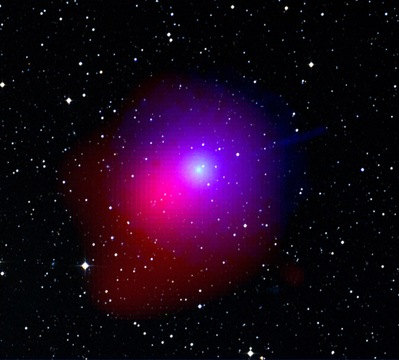
This image of Comet Lulin was taken by Swift on January 28, 2009. It shows data obtained by Swift's Ultraviolet/Optical Telescope (blue and green) and X-Ray Telescope (red). The image of the star field (white) was acquired by the Digital Sky Survey. At the time of the observation, comet Lulin was 99.5 million miles from Earth and 115.3 million miles from the sun.
Swift Mission Operations Center
The Pennsylvania State University301 Science Park Road,
Building 2 Suite 332,
State College, PA 16801
USA
☎ +1 (814) 865-6834
📧 swiftods@swift.psu.edu
Swift MOC Team Leads
Mission Director: John NousekScience Operations: Jamie Kennea
Flight Operations: Mark Hilliard
UVOT: Michael Siegel
XRT: Jamie Kennea
Swift Partners
UK: UCL MSSL Univ. of LeicesterUSA: NASA/GSFC LANL Omitron SwRI
Italy: SSDC/ASI INAF OA-Brera